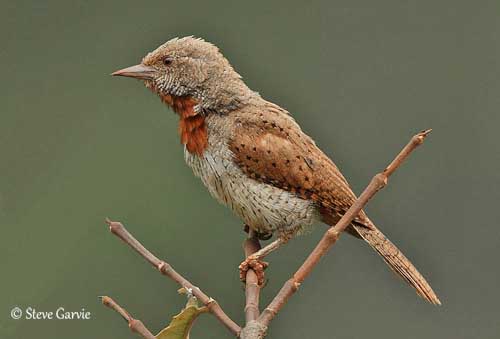
Fr: Torcol à gorge rousse
All : Rotkehl-Wendehals
Esp: Torcecuello Africano
Ital: Torcicollo africano
Nd: Afrikaanse Draaihals
Sd: Rödbröstad göktyta
Photographers:
Steve Garvie
RAINBIRDER Photo galleries
William Price
PBase-tereksandpiper & Flickr William Price
Dubi Shapiro
Dubi Shapiro Photo Galleries
Text by Nicole Bouglouan
Sources:
HANDBOOK OF THE BIRDS OF THE WORLD Vol. 7 by Josep del Hoyo-Andrew Elliott-Jordi Sargatal – Lynx Edicions – ISBN: 8487334377
BIRDS OF AFRICA SOUTH OF THE SAHARA by Ian Sinclair and Peter Ryan - Princeton University Press Princeton and Oxford - ISBN: 0691118159
ROBERTS BIRDS OF SOUTH AFRICA by G. R. Mc Lachlan and R. Liversidge – The Trustees of the John Voelcker Bird Book Fuund – ISBN: 0620031182
BirdLife International (BirdLife International)
Rufous-necked Wryneck
Jynx ruficollis
Piciformes Order – Picidae Family
BIOMETRICS:
Length: 19 cm
Weight: M: 52-59 g – F: 46-52 g
DESCRIPTION:
The Rufous-necked Wryneck belongs to the subfamily Jynginae, with the second member the Eurasian Wryneck.
Both are included in the Picidae family and are found in the Old World.
The plumage is cryptic. The adult has grey-brown upperparts with variable black streaks and bars on forehead, scapulars, wing-coverts, tertials and uppertail-coverts. The wing-coverts are white-tipped. There is a black stripe from crown to mantle, conspicuous seen from behind. The flight feathers are dark brown and slightly barred rufous-white. The tail is brownish-grey and barred black and conspicuously edges white. Crown sides, rump, wing-coverts, uppertail-coverts and tertials are often finely vermiculated.
On the underparts, chin, throat and upper breast are rufous-chestnut with variable extent. The central throat may be occasionally barred. Rest of underparts are whitish with dark brown shaft streaks. Flanks, lower belly and vent are washed buffy. Lower flanks and undertail-coverts are barred. The underwing is barred brown and pale rufous.
On the head, lores and ear-coverts are barred brown and creamy-white, whereas the malar area is whitish and vermiculated brown. The crown is grey-brown with black shaft streaks.
The bill is greyish-brown with darker tip. The eyes are brown. Legs and zygodactyl feet are brownish to dull greenish.

Jynx ruficollis ruficollis
Kenya
Both sexes are similar.
The juvenile has duller throat with less extent of rufous. It is darker above, with more barring.
We can find three subspecies:
J.r. ruficollis here described and displayed on this page.
J.r. aequatorialis has rufous chin, throat and entire breast and often the upper flanks, and then the lower flanks to lower belly and undertail-coverts. The underparts are more finely streaked.
J.r. pulchricollis is more rufous-tinged above. Throat and breast are chestnut rather than rufous. The throat is strongly barred and may lack the rufous tinge. The flanks are washed rusty. Lower belly and undertail-coverts are chestnut.
VOICE: SOUNDS BY XENO-CANTO
The Rufous-necked Wryneck male gives long series of 5-10 loud, harsh notes “kwik-kwik-kwik…”. The female utters lower-pitched series “uit-uit-uit…”. They sing from perch in dead tree.
We can also hear a low-pitched, guttural “peegh” repeated several times. The alarm call is a quiet “klik”.
During the displays, they give long series of “krok” notes.
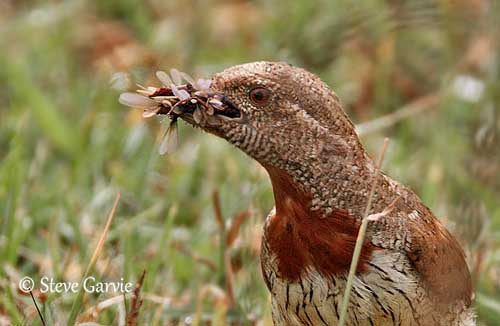
Jynx ruficollis ruficollis
Kenya
During the breeding season, courtship feeding from male to female is regular, including during the incubation. While displaying, the birds erect the feathers of crown and nape while head and bill are extended forwards. The tail is fanned.
They perform rhythmic movements of both head and body. The rufous patch is displayed too.
These displays occur between mates, but also in aggressive encounters. In response to intruders at the nest-site, the adults perform snake-like head movements and utter hissing sounds.
This species roosts in holes in tree-trunks.
It is largely resident, but may disperse sometimes.
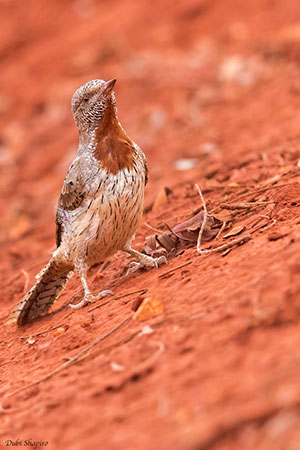
FLIGHT:
The Rufous-necked Wryneck performs low undulating flight and short flights from tree to tree.
REPRODUCTION:
The breeding season varies according to the range.
The Rufous-necked Wryneck nests in natural holes in tree-trunks, usually an abandoned nest of barbet or woodpecker. It does not excavate the hole, and uses crevices in trunk, and sometimes nest-box.
The female lays 3-4 white eggs, up to 6 occasionally. The incubation lasts 12-15 days, shared by both parents which also care and feed the chicks together. The young are fed with ants and their larvae and pupae. The adults deliver large beakfulls of this food to the nest.
This species often rears two broods in a season. The nests are often parasitized by Indicatoridae species.
DIET:
The Rufous-necked Wryneck feeds mainly on ants and their larvae and pupae, and also takes other small arthropods.
It forages and gleans prey items in tree-trunks, from the vegetation or on the ground.
PROTECTION / THREATS / STATUS:
The Rufous-necked Wryneck is locally common but its presence appears irregular throughout the range. This species is erratic, and the pairs are often scattered, but it occurs in many protected areas in Africa.
This species is not currently threatened.
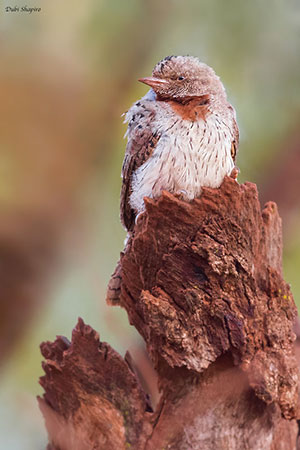
HABITAT:
The Rufous-necked Wryneck frequents wooded grasslands and open savannahs, woodland and forest edges. This species is widespread in dry acacia savannah and open bush, in wooded gorges and along streams. It also frequents suburban plantations and gardens.
It can be seen from 600 to 3000 metres of elevation or higher in Kenya, from 1400 to 2500 metres.
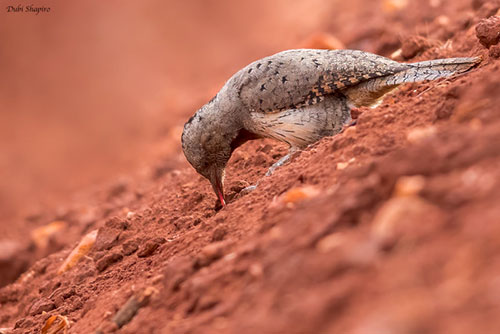
RANGE:
The Rufous-necked Wryneck of race “aequatorialis” is found in Ethiopia.
The race “pulchricollis” occurs in SE Nigeria and Cameroon to NW Zaire, S Sudan and NW Uganda.
The nominate race “ruficollis” is found from SE Gabon to SW and E Uganda, SW Kenya and extreme N Tanzania, N and E Angola, NW Zambia and E South Africa.
BEHAVIOUR:
The Rufous-necked Wryneck feeds primarily on ants, larvae and pupae, and also takes small arthropods.
It gleans ants from the bark in dead trees or from large bushes. It often forages on the ground by hopping and obtains food from terrestrial ants’ nests. It gleans and probes with its long sticky tongue.
It feeds its young with numerous items at once.
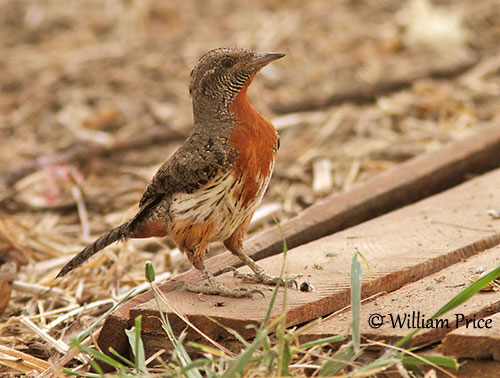
Jynx ruficollis aequatorialis
Ethiopia
Jynx ruficollis ruficollis
Tanzania
Jynx ruficollis ruficollis
Tanzania
Jynx ruficollis ruficollis
Tanzania